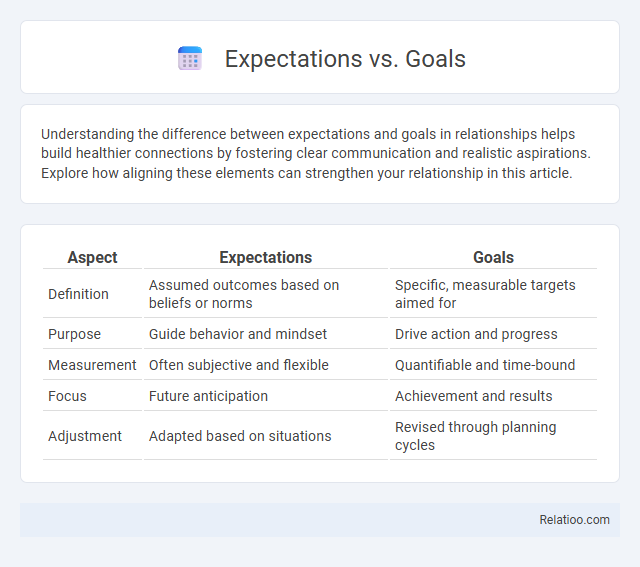Understanding the difference between expectations and goals in relationships helps build healthier connections by fostering clear communication and realistic aspirations. Explore how aligning these elements can strengthen your relationship in this article.
Table of Comparison
| Aspect | Expectations | Goals |
|---|---|---|
| Definition | Assumed outcomes based on beliefs or norms | Specific, measurable targets aimed for |
| Purpose | Guide behavior and mindset | Drive action and progress |
| Measurement | Often subjective and flexible | Quantifiable and time-bound |
| Focus | Future anticipation | Achievement and results |
| Adjustment | Adapted based on situations | Revised through planning cycles |
Understanding Expectations and Goals
Understanding the difference between expectations and goals is crucial for your personal and professional growth, as expectations often represent assumptions or desired outcomes set by others, while goals are specific, measurable, and self-directed targets you aim to achieve. Clear goal-setting provides a structured path toward success, enabling better alignment of efforts and resources compared to vague or uncertain expectations. Effective expectation management involves communicating and adjusting these perceptions to avoid misunderstandings and ensure realistic, achievable results.
Key Differences Between Expectations and Goals
Expectations represent beliefs about what may happen, often shaped by emotions or external opinions, while goals are specific, measurable objectives you actively set and pursue. Expectation management involves aligning others' perceptions with realistic outcomes to avoid disappointment, contrasting with the proactive planning and tracking inherent in goal-setting. Understanding these key differences helps you clarify your ambitions and communicate effectively to achieve desired results.
Why Setting Goals Matters
Setting clear goals transforms vague expectations into actionable targets, providing you with measurable milestones and a sense of direction. Proper expectation management prevents frustration by aligning your ambitions with realistic outcomes, enhancing motivation and focus. Effective goal-setting drives progress and empowers you to track achievements systematically, ensuring continuous personal and professional growth.
The Pitfalls of High Expectations
High expectations risk leading to disappointment when outcomes fall short of your anticipated results, causing frustration and decreased motivation. Goals provide clear, measurable targets that guide progress, while effective expectation management aligns your mindset with realistic possibilities to avoid unnecessary emotional setbacks. Understanding these distinctions helps prevent the common pitfall of setting overly ambitious expectations that hinder long-term success and satisfaction.
How Expectations Shape Behavior
Expectations significantly influence behavior by setting psychological benchmarks that guide actions and decision-making processes, often creating motivation or pressure to align outcomes with anticipated results. Goals serve as concrete, measurable targets within these expectations, providing clear direction and milestones that shape intentional behavior and effort. Effective expectation management involves aligning perceptions realistically to prevent disappointment and foster adaptive behaviors that accommodate both achievable goals and situational variables.
Turning Expectations into Achievable Goals
Turning expectations into achievable goals involves clearly defining specific, measurable outcomes based on initial hopes or assumptions. Effective expectation management requires breaking down broad expectations into realistic, time-bound objectives that align with available resources and potential constraints. This approach ensures progress tracking and reduces the risk of disappointment by transforming vague desires into structured, actionable targets.
Managing Disappointment: Expectations vs. Reality
Managing disappointment effectively requires understanding the difference between expectations, goals, and expectation management. Expectations are beliefs about future outcomes, while goals are specific, measurable objectives you set to achieve; mismatches between expectations and reality often lead to disappointment. Focusing on realistic expectation management helps align your mindset with achievable results, reducing frustration and improving resilience.
Strategies to Set Effective Goals
Setting effective goals involves defining clear, measurable, and time-bound objectives that align with your core values and long-term vision. Employing SMART criteria--Specific, Measurable, Achievable, Relevant, and Time-based--enhances goal clarity and trackability, promoting consistent progress. You can increase success by regularly reviewing goals, adjusting strategies based on feedback, and maintaining realistic expectations through proactive expectation management.
Balancing Optimism with Realism
Balancing optimism with realism requires distinguishing between expectations, goals, and expectation management to achieve success. Your goals set clear, measurable outcomes, while expectations are the beliefs or assumptions about future events, often influenced by optimism. Effective expectation management involves aligning these beliefs with realistic possibilities to minimize disappointment and maintain motivation.
Measuring Success: Did You Meet Goals or Just Expectations?
Measuring success requires distinguishing between meeting goals and fulfilling expectations, where goals are specific, quantifiable targets, while expectations are broader anticipations often influenced by perception. Your ability to track key performance indicators (KPIs) and outcomes directly linked to goals provides a clear metric for achievement, contrasting with the subjective nature of expectation management. By aligning your goals with tangible results and managing expectations transparently, you ensure a more accurate assessment of success.

Infographic: Expectations vs Goals
 relatioo.com
relatioo.com